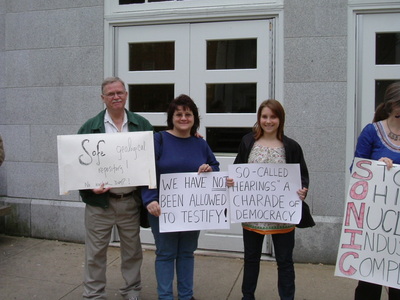
The family that protests together...: Richard, Dana, Ilona demonstrating against a nuclear dump they want to build down the road apiece. (Photo by Loraine McCosker)
In a single cry
the pheasant has swallowed
the fields of spring.
---Yamei
The real miracle is not to walk on water or thin air but to walk on the earth!
---Thich Nhat Hanh
Music is your own experience, your thoughts, your wisdom. If you don't live it, it won't come out your horn.
---Charlie Parker
I went to my dentist for the semi-annual checkup yesterday, and noticed a new product in the little bag of stuff they give you afterwards. I wisecracked to the receptionist that Listerine must be sending my doctor and his family on a cruise somewhere. She was quick to reply he never takes anything from companies except the free samples. I was happy to hear that.
Whereupon I gave her an earful about my family doctor's office. I said I hadn't been in there even once in the past 2 years (and I go maybe 3 times a year---they want to get all they can out of my insurance company) when there wasn't a drug salesperson pushing pills. These people are particularly sickening, as they try to get from the reception window into the back area to unload their suitcases full of drugs and bribe the doctors. The payoffs are free dinners, trips, and various toys to be strewn all over the place with big long names of pills on them. Undoubtedly they hope some patients will steal the toys to take home and spread the word. Free advertising. The dinners are gigantic feasts, and receptionists are encouraged to have to doctor invite all their friends if they want to. This is done in brazen broad daylight in front of a room of patients, waiting hour after hour to get that prescription.
I was in there last week, for a sprained foot I wanted X-rayed, and the drug lady was suggesting perhaps the doctors would like a new restaurant this time. Maybe one in Columbus or Parkersburg, a finer one, a richer one. The receptionist said she'd ask. "And oh!" the pusher said, "did you notice my new outfit?" She did a little swirl in front of the window. "It's color coordinated with our featured capsule!" I couldn't believe my ears. "See? The same colors as (she named the drug). Even the waistband is the color of the little separating line." I felt nauseated, and nearly stood up and let her have it. This is our health system in action, and I'm about to go in an office for treatment that will pay for this woman's salary, costume, and a doctor's free vacation courtesy of pharmaceuticals.
Maybe 20 years ago or more doctors started giving us free samples of drugs they were prescribing. I appreciated that because sometimes I was sick with flu or something, and just felt like going back to bed rather than a drug store to get medication. But since then, the practice has become obscene. Is this the free market the people in power tell us is a new religion solving the world's problems? If so, I want out! I'll gather roots and herbs in the woods before I'll take any more of this horror show. Have a look at TruthOut's article on the mess from Monday afternoon~~~
Prescription Drugs: Where's the Free Market?
By Dean Baker
t r u t h o u t Columnist
Monday 04 June 2007
For the last several years The New York Times has run articles almost every week exposing abuses by the prescription drug industry. (It had two last weekend Doctor Says Drug Maker Tried to Quash His Criticism of Avandia and After Sanctions, Doctors Get Drug Company Pay.) The stories usually document indirect payoffs to doctors for prescribing drugs, such as exorbitant speaker fees, expense-paid trips to industry-sponsored seminars at resort locations, or excessive fees for participating in clinical trials. In some cases the articles document outright kickbacks, as when the NYT reported that doctors who administer an anemia drug in their office could receive tens of thousands of dollars annually in rebates from the manufacturer.
The abuses also affect the research that is used to establish a drug's safety and effectiveness. There have been many incidents in which drug companies have concealed evidence that their drugs may not be more effective than cheaper alternatives. In some cases, they have concealed evidence of negative side effects from the public and the Food and Drug Administration. And, there is the problem that drug companies often pay researchers to sign their names to articles touting the benefits of their drugs, which the researchers did not write.
Such abuses should not be surprising to anyone who appreciates the value of a competitive market. The root cause of all of these problems is government-granted patent monopolies that allow the pharmaceutical industry to sell drugs at prices that can exceed the cost of production by a factor of a hundred, or more. Last fall, Wal-Mart began selling hundreds of generic drugs for $4 per prescription. The vast majority of brand drugs could also be profitably sold for $4 per prescription, if it were not for the patent monopoly granted by the government.
As a result of patent monopolies, drug companies can sell drugs for hundreds of dollars that cost them a few dollars to manufacture. This situation invites the sort of corruption that NYT documents regularly in its pages.
Drug patents do serve a purpose: they provide an incentive to the industry to develop new drugs. However, there are other ways in which this research can be financed. The federal government already spends nearly $30 billion a year on biomedical research conducted through the National Institutes of Health. By doubling this amount, it could probably replace the research conducted by the pharmaceutical industry, most of which currently goes to develop copycat drugs (another problem of the patent system).
As another possible alternative, Nobel Laureate Joe Stiglitz has suggested a prize system, in which the government would buy out patents at prices determined by their usefulness. The patents would then be placed in the public domain so that all new drugs could be sold as generics.
The United States spends almost $240 billion a year on prescription drugs, which comes to $800 per person. The cost of prescription drugs are a major burden to millions of low and moderate income households as well as to the government itself, which now picks up much of the tab through Medicare and Medicaid. In addition, hundreds of millions of people in the developing world are denied access to prescription drugs because they cannot afford to pay patent-protected drug prices.
The time has long passed when we should be seriously considering alternatives to patent financed research for prescription drugs. However, the power of the pharmaceutical industry has largely kept any such discussion off the political agenda.
A recent article in The Nation triggered a debate in the blogosphere as to whether the methodology of mainstream economics prevents it from considering important issues. In the case of patent financing of prescription drug research, there are no methodological issues at stake. Economists could use the exact same models that show the losses from trade barriers on shoes and shirts to quantify the much larger economic harm from patent monopolies on prescription drugs.
Unfortunately, the political force behind protection for prescription drugs is much greater than the political force behind protection for shoes and shirts. Therefore, we can look forward to reading many more articles in the NYT about abuses in the prescription drug industry.
--------------------------------------------------------------------------------
Dean Baker is the co-director of the Center for Economic and Policy Research (CEPR). He is the author of The Conservative Nanny State: How the Wealthy Use the Government to Stay Rich and Get Richer (www.conservativenannystate.org). He also has a blog, "Beat the Press," where he discusses the media's coverage of economic issues. You can find it at the American Prospect's web site.
http://www.truthout.org/docs_2006/060407D.shtml
http://www.truthout.org/docs_2006/060407D.shtml

No comments:
Post a Comment